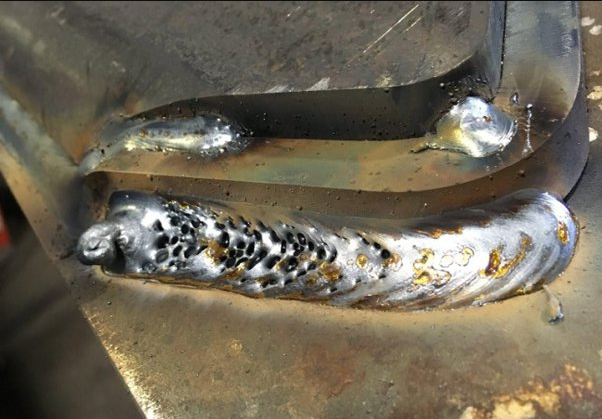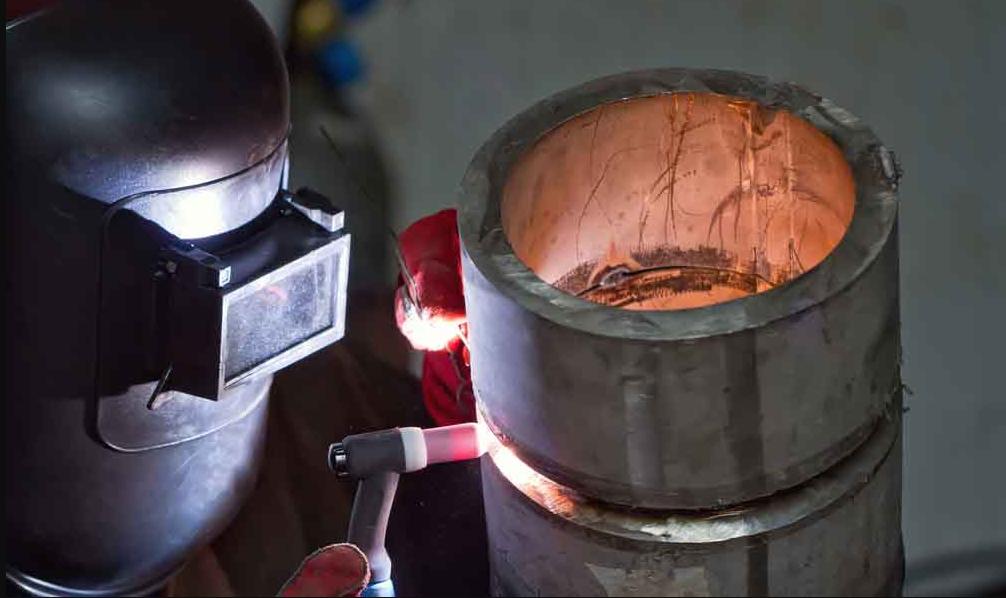Adding oxygen or CO2 to argon enhances weld stability, efficiency, and bead aesthetics on steel.
Properties of Shielding Gases
Shielding gases play a pivotal role in determining the quality, appearance, and characteristics of welds. By influencing the stability of the arc and the behavior of the weld puddle, these gases are indispensable to the welding process.

Argon and its characteristics in welding
Argon, a noble gas, is one of the most popular choices for welding, especially in Tungsten Inert Gas (TIG) welding. Its primary benefits include:
- Stability: Argon provides a stable arc, reducing spatter and ensuring a cleaner weld.
- Inert Nature: As a noble gas, Argon doesn’t react with the weld pool, ensuring a contamination-free joint.
- Versatility: Suitable for welding various metals, including aluminum, stainless steel, and more.
For more insights, see the Argon Wikipedia page.
Oxygen and its role when mixed with argon
Introducing a small amount of oxygen to argon can dramatically influence the weld’s characteristics. Some key advantages are:
- Improved Fluidity: The addition of oxygen can enhance the fluidity of the weld puddle, making it spread more evenly.
- Better Penetration: Oxygen helps achieve deeper penetration, particularly useful for thicker materials.
- Arc Stability: While argon alone provides a stable arc, a touch of oxygen can further enhance this stability, especially in certain conditions.
For more detailed information, visit the Oxygen Wikipedia page.
Carbon Dioxide (CO2) and its contribution in welding processes
CO2 is another commonly used additive to argon, especially in Metal Inert Gas (MIG) welding. Some of its prominent attributes include:
- Cost-Effectiveness: Pure argon can be expensive. Mixing it with CO2 can help reduce costs without compromising too much on weld quality.
- Reduced Spatter: CO2, when mixed in the right proportion with argon, can result in less spatter, making post-weld cleanup easier.
- Heat Control: CO2 aids in producing a hotter arc, which can be beneficial for certain welding applications.
For a deeper dive into CO2, check out the Carbon Dioxide Wikipedia page.
Advantages of Adding Oxygen to Argon
The welding industry often explores various shielding gas compositions to achieve desired welding characteristics. Introducing oxygen to the primarily inert argon offers a suite of benefits that enhance welding outcomes.
Improved arc stability and control
When you mix a small percentage of oxygen with argon, the electric arc’s stability significantly improves. This stability is crucial for both novice and experienced welders as it offers:
- Consistency: Achieving a consistent weld is easier with a stable arc.
- Precision: With better arc control, welders can achieve more precise welds, especially in intricate or detailed applications.
More on arc welding can be found on the Arc Welding Wikipedia page.
Enhanced weld puddle fluidity
Weld puddle fluidity is another area that benefits from the addition of oxygen. By making the weld puddle more fluid:
- Spreading: The weld material spreads more evenly across the joint, ensuring a uniform weld bead.
- Visibility: A more fluid puddle offers better visibility, enabling welders to see the weld’s progress and adjust accordingly.
Reduction in surface tension leading to better wetting
Surface tension plays a critical role in how well the molten weld metal wets the base metal. With oxygen:
- Improved Adherence: The weld metal adheres better to the base material, reducing instances of undercuts or poor fusion.
- Smoother Beads: Weld beads become smoother and more aesthetically pleasing, often reducing the need for post-weld grinding.
For a more scientific take on surface tension, the Surface Tension Wikipedia page is a great resource.
Improved weld penetration on thicker materials
Thicker materials present a challenge due to the need for deeper penetration to ensure a strong weld. Oxygen’s introduction to argon:
- Depth: Enables the weld to penetrate deeper into the base material.
- Strength: Ensures a robust and durable joint that can withstand greater stresses, making it particularly beneficial for structural applications.
For more about the importance of penetration in welding, check out the Welding Wikipedia page.
Advantages of Adding CO2 to Argon
Incorporating CO2 with argon in the welding process has been recognized for its myriad benefits. The combination leads to improved outcomes in various facets of the welding process. Here are the explicit advantages of adding CO2 to argon:
Cost-Effectiveness Compared to Pure Argon
Using a mixture of argon and CO2 can be more cost-effective than using pure argon:
- Economic Benefits: For large-scale welding projects or ongoing industrial applications, the mixed gas can save substantial amounts for businesses.
- Wide Availability: The mixed gas is readily available globally, making it a practical choice for most welding endeavors.
For more on argon, see the Argon Wikipedia page.

Enhanced Arc Stability, Especially in MIG Welding
CO2 aids in strengthening and stabilizing the arc, with pronounced benefits in MIG welding:
- Reduced Spatter: A stable arc can lead to reduced metal spattering, diminishing post-weld cleanup.
- Higher Efficiency: The stability of the arc streamlines the welding process, making it quicker and more efficient.
To dive deeper into MIG welding, the MIG Welding Wikipedia page is worth a visit.
Increased Weld Bead Profile and Aesthetics
The welding gas mixture of CO2 and argon not only delivers in strength but also heightens the overall aesthetics of the weld:
- Smoother Surfaces: Weld beads produced by the mixed gas are typically smoother with fewer pits and irregularities.
- Consistency: Uniform weld profiles give structural parts a neater and more professional appearance.
Better Control Over Spatter in Certain Conditions
Spattering can pose issues in the welding process, especially in high-intensity welding applications. The inclusion of CO2 helps better control this phenomenon:
- Less Cleanup: Reduced spattering equates to less cleanup.
- Protecting the Weld: Minimized spattering means the weld is less exposed to contaminant impurities, enhancing the weld’s overall quality and strength.


